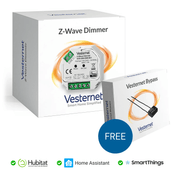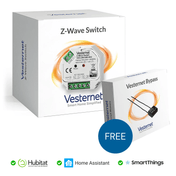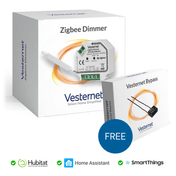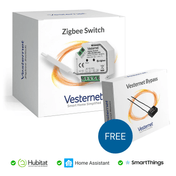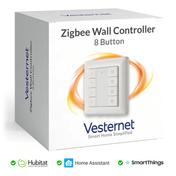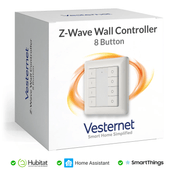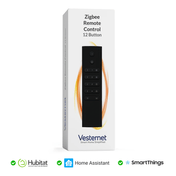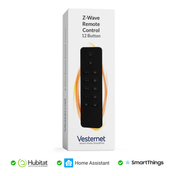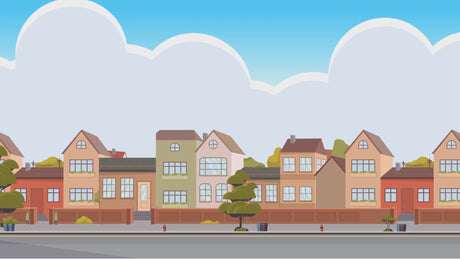Z-Wave Groups, Scenes & Associations
Z-Wave provides an array of features that go way beyond simply providing wireless control of devices. Z-Wave is one of the most versatile Home Automation technologies available today.
With Z-Wave, you can operate individual devices and appliances such as lights, heating and window blinds, but you can also create “Groups”, “Scenes” and “Events” enabling you to create a sophisticated system to automate the control of your home.
- Groups - a collection of individual devices controlled as a group. For instance they can all be turned On/Off by one button or action.
- Scenes - enable a single button to send different commands to different devices. Making several different things happen at the same time.
- Events - reacts to a trigger and then instigates a command to a Group or Scene. For instance when a motion detector is tripped a light comes on.
These features make it easy for you to configure a sophisticated home automation system that does exactly what you want and when you want it.
For instance, when you’re on holiday, it’s good to know that the lights will automatically switch off - no worrying about having left a light on. The system can even be configured to send you messages if particular Events are triggered.
Don’t confuse ‘Sophisticated’ with ‘Complicated’. Z-Wave components are designed to work well together, and Z-Wave controllers such as the VERA Gateway are perfect for setting-up and controlling your network. Whether you’re at home or on the other side of the world, VERA will keep you informed about what’s happening at home and even allow you to control your system from your Smartphone or PC.
Z-Wave technology is great for bringing stylish control to your home, monitoring and helping you reduce your energy bills and protecting your home.
You can get the most out of your Z-Wave system, by understanding how to manage it using Association, Groups and Scenes.
Associations
Association is different to Inclusion. The Inclusion function of a device “includes” the device into a network, allowing it to communicate with other network devices. The association function “associates” two devices, enabling them to communicate directly without the need for a central controller. Most devices have a button that sets the device to Inclusion/Association mode.
A typical Z-Wave network comprises of Controllers (devices that control other devices) and Slaves (devices that are controlled by other devices). A Controller communicates with Slaves in two ways:
- Send commands to change the status of the slave device - turn them On or Off
- Receive status information from the slave - movement from a motion detector
Slaves are also able to communicate directly amongst themselves without the involvement of the network controller.
Example:
A network has a Z-Wave controlled power switch and a motion detector (both Slaves). We would like the switch to turn On when movement is detected.
One setup would be for the motion detector to send a signal to the controller and as a second step the controller sends a command to the power switch. However this means that:
- The controller is added as an additional source of failure
- The communication takes much longer then necessary
- The controller needs to be in the listening mode, which means it needs to be a static controller
Associating the motion detector with the power switch, enables it to send signals directly to the power switch without involving the controller. This saves time, reduces the complexity of the communication and the amount of airtime taken. It also allows sensors to be used in networks without a static controller.
To be able to use an association, the sending node (the motion detector) must have knowledge of a valid route to the destination (in the example the power switch) - it needs to understand network routing to other devices. Therefore only a routing slave or a controller can use associations. A normal slave doesn’t have any information about routes and can only send signals as an answer to received commands (from a controller).
In order to set an association the sender needs to learn the Node ID and Receiving Node ID of all devices that will be associated, these are included in Node Information Frames that are sent across the network.
There are two different ways to associate devices:
Direct Association:
This is the simplest form of associating Z-Wave devices.
- The ‘Source node’ of the association will be set to “association set mode” - it can ‘listen’ for node information frames from other network devices
- The ‘Target node’ sends its node information (by pressing a button on the device)
- The node information received by the Source node contains the Node ID of the Target node (device) and allows it to set the association.
Because the node information frame is always sent as a broadcast to all nodes “in range”, direct association only works if both sender and target are “in range”. They must have a direct not routed wireless connection established. If one of the devices is moved “out of range”, the association will be broken.
Assigned Association
Assigned associations allow you to connect two Z-Wave devices that are not “in range”. To do this the help of a third node (Connecting Controller), a controller with knowledge of the complete network and its routes, is needed.
The Connecting Controller is set to “association mode”, it now expects (1) a node information frame from the desired source and in a second step (2) a node information frame from the desired target node. Again the node Information frame can only be received by nodes in range, hence the controller needs to be brought in direct wireless range of the two nodes, but not at the same time.
- First the Connecting Controller is placed near the Source node
- It’s set to “association mode” allowing it to receive the node information frame from the Source node
- Then it’s placed near the Target node to receive that node information frame as well
- Finally, the controller communicates with the Source node, providing node information about the Target node and the correct routing
- Since the controller knows the route to the target node, there’s no need to bring the controller back in range to the target to perform the final configuration
- The association is now set and communication between the source and target nodes is routed through the network
A single source node can be associated with multiple target nodes. All target nodes will then receive all commands sent from the source node at the same time. This is great for home security applications where a detector, when triggered by an event, would need to send an alert to a number of different devices at the same time.
It’s also possible to have multiple different events, which would need to send commands to different nodes. This is easily configured by assigning a number of target nodes to an ‘association group’ and associating the group with a particular event.
An example of a Z-Wave device with association is a wall switch that has two switching paddles (left and right).
For this particular product there should be at least two association groups, one for each paddle. Most wall switches include more groups that can be activated when doing a double-press or when both paddles are pressed at the same time.
Typically the number of receiving nodes per group is limited to five devices. This limitation is due to the limited memory capacity of most devices, however, some devices do have higher memory capacities and support more target nodes.
If nodes are assigned to a device’s association group, the device will send a signal to all the target devices every time this groups gets activated – typically by pressing a button, a combination of buttons or when a sensor value reaches a certain level.
To ensure the maximum number of different target devices can be controlled, most devices with association functions will use the BASIC command class to control target devices. However, there are devices available that offer to configure which command class is to be used to control target devices. With this feature it‘s possible to execute very special functions on the target devices.
Associations are also used to assign certain remote control buttons to certain devices in a Z-Wave network.
Groups
Groups enable multiple devices to be controlled from one single button on a remote control, just as if they were one single device. A single command makes all devices in the groups switch On/Off at the same time. Since all devices in a group receive the same commands, it’s useful to group similar devices into one group. If different devices are mixed, you may get confusing results.
Similar to associations, most remote controls only use the BASIC command class to control groups. This allows different devices to be mixed, but only to a certain extent. Mixing a dimmer and a switch will result in the dimmer acting as a switch.
Most remote control instructions describe the switching of groups but don’t refer to the switching of a single device. To switch a single device just place this device into a group and switch the group. It‘s also possible to assign one device to different groups.
Scenes
Being able to define and use Scenes is one of Z-Wave’s most powerful features. Like Groups, Scenes group together multiple devices. However, while groups treat all devices similarly, scenes enable a controller to send different commands to different devices. This results in endless possibilities such as: “turn light switch off and open window B” or “dim all lamps to 50 % and turn on the TV”.
Scenes are very flexible and much more powerful than groups, but take a lot of memory to store the different commands. Therefore, a remote control will normally support fewer scenes than groups. Static controllers such as IP gateways or PC software typically allow an almost unlimited number of scenes.
Comparison of Groups, Scenes and Associations
Groups, Scenes and Associations are different ways to enable functions and interactions within the Z-wave network.
|
|
Used in |
Function |
|
Associations |
Slaves |
Sends control signals to one of more target devices (Slaves or controller) |
|
Groups |
Slaves and controllers |
Grouping of multiple devices receiving the same control message - typically via association (from Slaves or controllers) |
|
Scenes |
To controllers |
Activation of a scenes leads to switching different devices using different control messages |
Using IP-Gateways
IP Gateways allow a very user-friendly configuration and usage of a Z-Wave network. You can access different functions and sensor values using a convenient web interface or even a mobile phone like the iPhone.
These gateways enable you to control all aspects of your network, making it easy to tweak your home automation system to do exactly what you need:
- Devices can be assigned to different rooms or zones of the home - some gateways even allow you to upload you floor plans
- Definition and activation of Scenes - scenes can be defined for the whole home or for different parts of the home, such as different rooms
- Defined Scenes can be activated depending on certain conditions, for example:
- A sensor value reaches a particular value - activate open window scene and turn heat down when CO2 sensor reaches 100 ppm
- A button is pressed - turn off all electrical devices and lights when the “all off” button (near the front door ) is pressed
- A certain time is reached - turn down all window blinds 30 minutes after sun set
- Boolean logic determines the event - turn on all outside lights when time is between 18.00 and 0600 AND “all off” button is pressed
Multiple scenes can be run in parallel, even using the same devices. However, you do need to ensure no contradicting commands and settings are defined.
As well as switching devices, a scene can trigger more functions such as sending of an email or an SMS or calling a predefined phone number.
When configuring an IP Gateway you should carefully consider the following points:
- Reporting of status changes of devices caused by local usage rather than initiated via the wireless network
- Associations configured directly on the devices rather than set by the user GUI of the IP Gateway
- Scene activation using Z-Wave remote controls or other wall controllers
Advanced, sophisticated control - made easy
Z-Waves’s Groups, Associations and Scenes make it easy for you to create a sophisticated home automation system that caters for your every need, without complex configuration and set up. Your home can easily resemble those homes you see in films or you thought were just imagined for the future.
Vesternet is Europe’s leading home automation specialist, take a look at our huge range of Z-Wave products.









